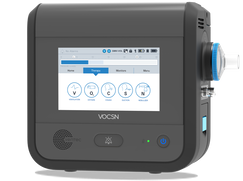The multi-function ventilator integrates the capabilities of a portable ventilator, cough assist, suction machine, oxygen concentrator, and nebulizer into one portable respiratory device.
A multi-function ventilator can be used noninvasively with a mask, invasively with a trach, or with a mouthpiece. The integration of multiple therapies into one 18-pound device means fewer cables, greater mobility, and just one machine to operate.
How does it work noninvasively?
|
You can use a multi-function ventilator just like you would use a portable ventilator. You can use it at night with a mask or interface, or use it during the day for either intermittent or continuous breathing support.
When you need to use cough assist or suction, you just change the mode on the touchscreen and attach the corresponding mask and tubing. Most ALS patients won’t need the oxygen concentrator or nebulizer, which vaporizes certain respiratory medications for inhalation. |
|
How does it work invasively?
|
If you have a tracheotomy, the multi-function ventilator will connect directly to the trach opening in your windpipe and breathe for you 24/7, just like a portable ventilator.
A key benefit of the multi-function ventilator is that when you need cough assist or suction, you don’t have to disconnect from the ventilator and switch machines. This makes transitions easier, saves your caregiver time, and minimizes the risk of infection. |
|
How portable is it?
|
Multi-function ventilators allow you to move around your home, go out, and travel with much greater ease. Instead of having to pack up to five different machines, you can attach one device to the back of your wheelchair and go. The multi-function ventilator has two removable, hot swappable batteries, an external battery charger, and the ability to plug into the battery of your wheelchair.
|
Where can I get one?
In order to qualify for a multi-function ventilator, your neurologist or pulmonologist will need to write a prescription and provide documentation that you qualify for a ventilator (for either invasive or noninvasive use) and one of the additional therapies (oxygen, cough, suction, or nebulizer).
A durable medical equipment (DME) company will then process your order. The multi-function ventilator will generally be delivered to your home, where you will receive training in device setup and use. If you get a tracheotomy, your caregivers will be trained in the hospital after surgery.
A durable medical equipment (DME) company will then process your order. The multi-function ventilator will generally be delivered to your home, where you will receive training in device setup and use. If you get a tracheotomy, your caregivers will be trained in the hospital after surgery.



